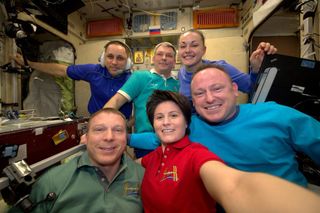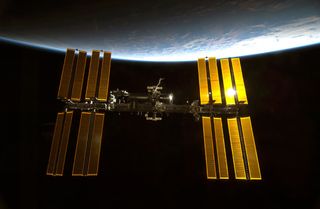US-Russian Space Crew Returns to Earth After 167 Days in Orbit

An American astronaut and two Russian cosmonauts have landed safely on after 167 days in orbit at the International Space Station. The space travelers was all smiles despite below-freezing temperatures of their snow-covered landing site in Kazakhstan.
"I'm glad to be back," NASA astronaut Barry "Butch" Wilmore said after being pulled from the Soyuz space capsule alongside his Russian crewmates Alexander Samokutyaev and Elena Serova. Wilmore wore a broad grin and gave a thumb's up sign to cameras.
The Soyuz landed on the frigid steppes of Kazakhstan in Central Asia at about 8:07 a.m. local time on Friday, March 12, (10:07 p.m. March 11 EDT) in a smooth landing despite sporadic communications with Russia's Mission Control during most of re-entry. The crew traveled 71 million miles during their nearly six-month mission to the space station. [See photos of their space station mission]
The landing site was covered in a thick blanket of fog, making visibility difficult for recovery crews. Temperatures hovered around 20 degrees Fahrenheit (minus 6 degrees Celsius), NASA spokesman Rob Navias said during the agency's landing commentary.
This mission marked Serova's first flight to space. She became the fourth Russian woman to fly in space during the spaceflight.
"I want to say hello to all my relatives," Serova said after the landing, which she said felt great. She waved and blew a kiss to video cameras while some recovery team members congratulated her on the recent International Women's Day, which occurred on March 8.
Samokutyaev, meanwhile, took comfort in a simple pleasure.
Get the Space.com Newsletter
Breaking space news, the latest updates on rocket launches, skywatching events and more!
"I am drinking tea with real lemon," he said as he sipped from a tin mug. "It's great."
The mission marked the second career flight for both Samokutyaev and Wilmore. In total, Samokutyaev has spent 331 days in space, and Wilmore has spent 178 days in orbit, according to NASA.

Serova, Samokutyaev and Wilmore leave behind three other crewmembers on the International Space Station. NASA astronaut Terry Virts, cosmonaut Anton Shkaplerov and European Space Agency astronaut Samantha Cristoforetti will continue living and working on the orbiting outpost until later this year.
"What a blessing to have this group of people assembled together," Wilmore said as he was passing command of the space station to Virts during a ceremony Tuesday (March 10). "The joy, the fun that we've had together, the work that we've done together has just truly been amazing … It's been such a joy."
The space station's remaining crew apparently followed the Soyuz's landing from orbit, with Cristoforetti taking to Twitter to congratulate her colleagues' successful landing.
"Good to know you're safe back on Earth!" Cristoforetti wrote in the Twitter post. Earlier, the crew had posed for one final group photo before the Soyuz undocked from the space station for good.
Shkaplerov, Cristoforetti and Virts won't be alone on the space laboratory for long. Cosmonauts Mikhail Kornienko, Gennady Padalka and NASA's Scott Kelly will join the other trio of crewmembers on March 27 when Kornienko, Padalka and Kelly fly up to the station aboard their own Soyuz.
Kornienko and Kelly's flight in March will mark the start of the space station's first year-long mission. While cosmonauts have spent full years in space before, this spaceflight will be the first yearlong mission for an American, and the first year-long mission for anyone on the space station.
NASA currently relies on Russia's Soyuz spacecraft to deliver astronauts to and from the space station, but that could change in the coming years. The private spaceflight companies SpaceX and Boeing are currently developing crewed vehicles that could ferry astronauts to the station from Earth and home again. NASA officials hope at least one of those vehicles will be available to fly astronauts to the station from U.S. soil by 2017.

A rotating crew of astronauts and cosmonauts have staffed the $100 billion International Space Station since 2000. Construction of the outpost began in 1998.
Follow Miriam Kramer @mirikramer. Follow us @Spacedotcom, Facebook and Google+. Original article on Space.com.
Join our Space Forums to keep talking space on the latest missions, night sky and more! And if you have a news tip, correction or comment, let us know at: community@space.com.

Miriam Kramer joined Space.com as a Staff Writer in December 2012. Since then, she has floated in weightlessness on a zero-gravity flight, felt the pull of 4-Gs in a trainer aircraft and watched rockets soar into space from Florida and Virginia. She also served as Space.com's lead space entertainment reporter, and enjoys all aspects of space news, astronomy and commercial spaceflight. Miriam has also presented space stories during live interviews with Fox News and other TV and radio outlets. She originally hails from Knoxville, Tennessee where she and her family would take trips to dark spots on the outskirts of town to watch meteor showers every year. She loves to travel and one day hopes to see the northern lights in person. Miriam is currently a space reporter with Axios, writing the Axios Space newsletter. You can follow Miriam on Twitter.
